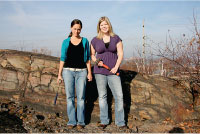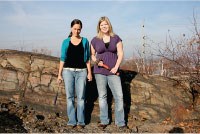
The Mineral Exploration Research Centre (MERC), a research centre affiliated with Laurentian University’s Department of Earth Sciences, is undertaking a series of research projects to better understand the geology of the Sudbury Igneous Complex (SIC).
Funded by the Centre for Excellence in Mining Innovation (CEMI), also based at Laurentian, the research focuses on knowledge gaps identified by the four mining companies active in the Sudbury area.
Despite a history of mining exceeding 100 years, "there is still a lack of basic knowledge of Sudbury’s geology," said Bruno Lafrance, associate professor of Earth Sciences at Laurentian.
Three projects are currently under way, the first of which focuses on the evolution of the contact metamorphic aureole, a region of rocks underlying the melt sheet resulting from the meteorite impact that formed the Sudbury Basin 1.85 billion years ago.
"The melt sheet was quite hot, possibly as much as 1800 degrees Celsius," explained Doug Tinkham, an assistant professor and one of the principal investigators for the study. "This melt sheet would have been lying on top of the rocks, so there would have been a lot of heat transfer to the underlying rocks."
At 690 or 700 degrees Celsius, the minerals within the rocks would have melted.
"There is evidence of partial melting within the footwalls of the SIC very close to the contact, but it’s not always very clear, so one of the goals of this project is to characterize and describe the various textures that we see in the footwall rocks and try to determine which textures are indicative of partial melting and which ones are not," said Tinkham.
The four-year study will shed light on the temperature distribution in the footwall rocks and the possible relationship between mineralization and anomalously high temperatures.
It will also advance our knowledge of how partial melting affected different rock types.
The second of three studies currently under way is a comparative study of mineralized and unmineralized breccias along the Whistle Offset dyke on the North Range of the SIC.
A rock type consisting of angular fragments cemented together, breccias are preferred hosts to copper-nickel-PGE mineralization in footwall country rocks and offset dykes of the SIC.
The study will examine the mineralogy, geochemistry and texture of rock samples in the hope of identifying any characteristics specific to mineralized breccias.
"If we can come up with some key features that help us recognize why some breccias are mineralized and some are not, we can use this knowledge as a prospective exploration tool," said Andy McDonald, department chairman. "What we find out about the genesis and evolution of these breccias could help us understand what happens in other impact structures on the planet."
The third study focuses on the metamorphic, structural and geochronological evolution of the South Range of the SIC.
Unlike the North Range, the South Range, or the southern rim of the SIC, has been affected by several orogenic, or mountain-building events, caused by tectonic movements that displaced and folded Huronian footwall rocks and nickel-copper massive sulphide deposits at the base of the SIC.
"As a result of the deformation, the mineralogy, the grades of the deposits and the geometry of the deposits were changed," said Lafrance. "In order to know the effects of those changes on the deposits, we need to know what caused the deformation and how many deformation events there were."
The focus on footwall and offset dyke deposits reflects the heightened interest in these rich copper-PGE deposits, which were generally overlooked until recently.
According to McDonald, these and other studies to follow are part of a department-wide initiative to better understand the footwall environment of the SIC.



